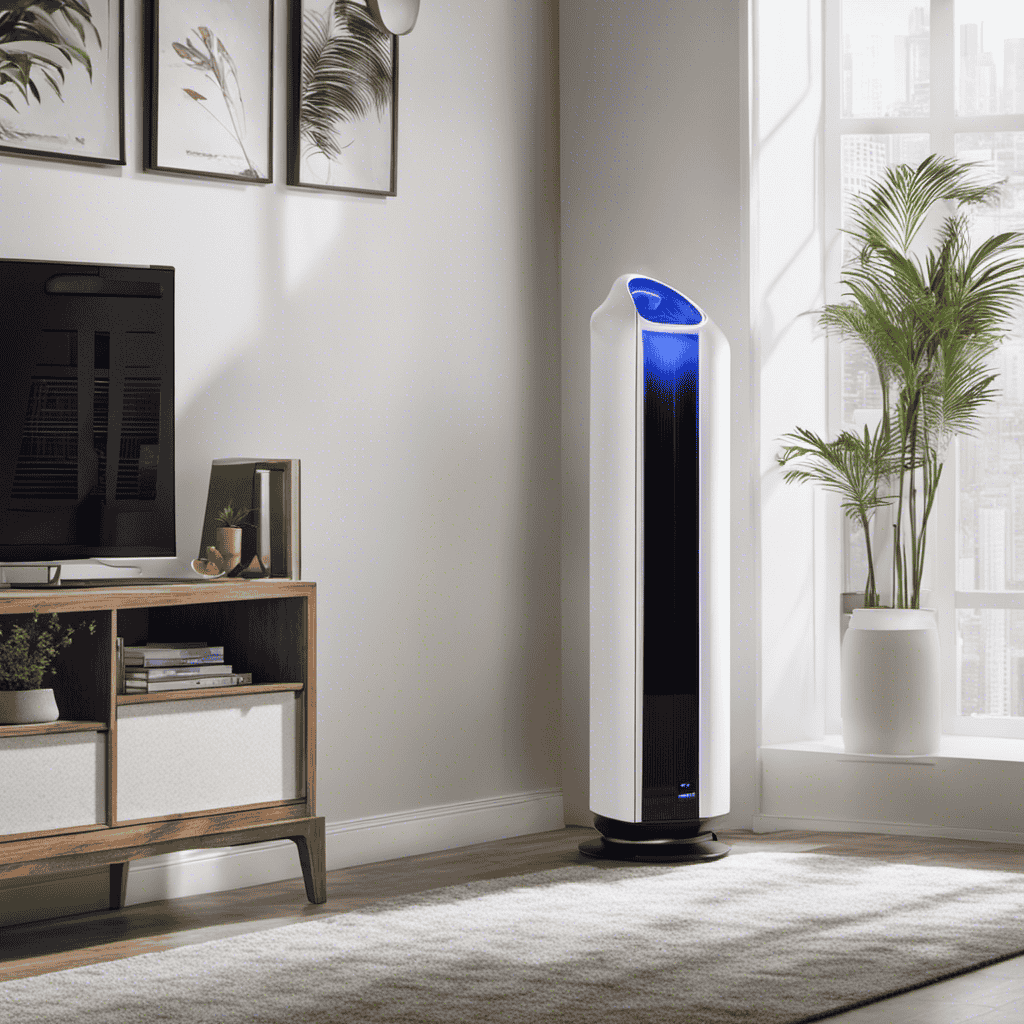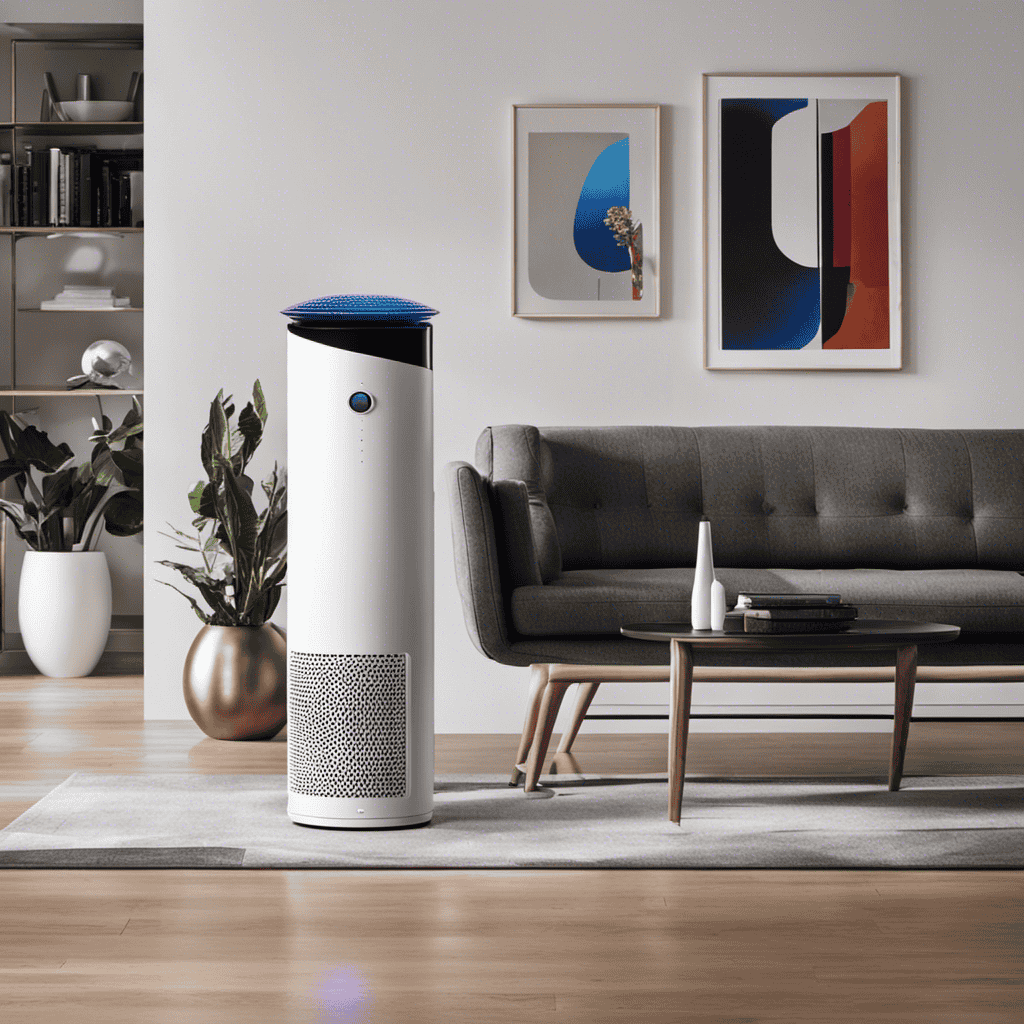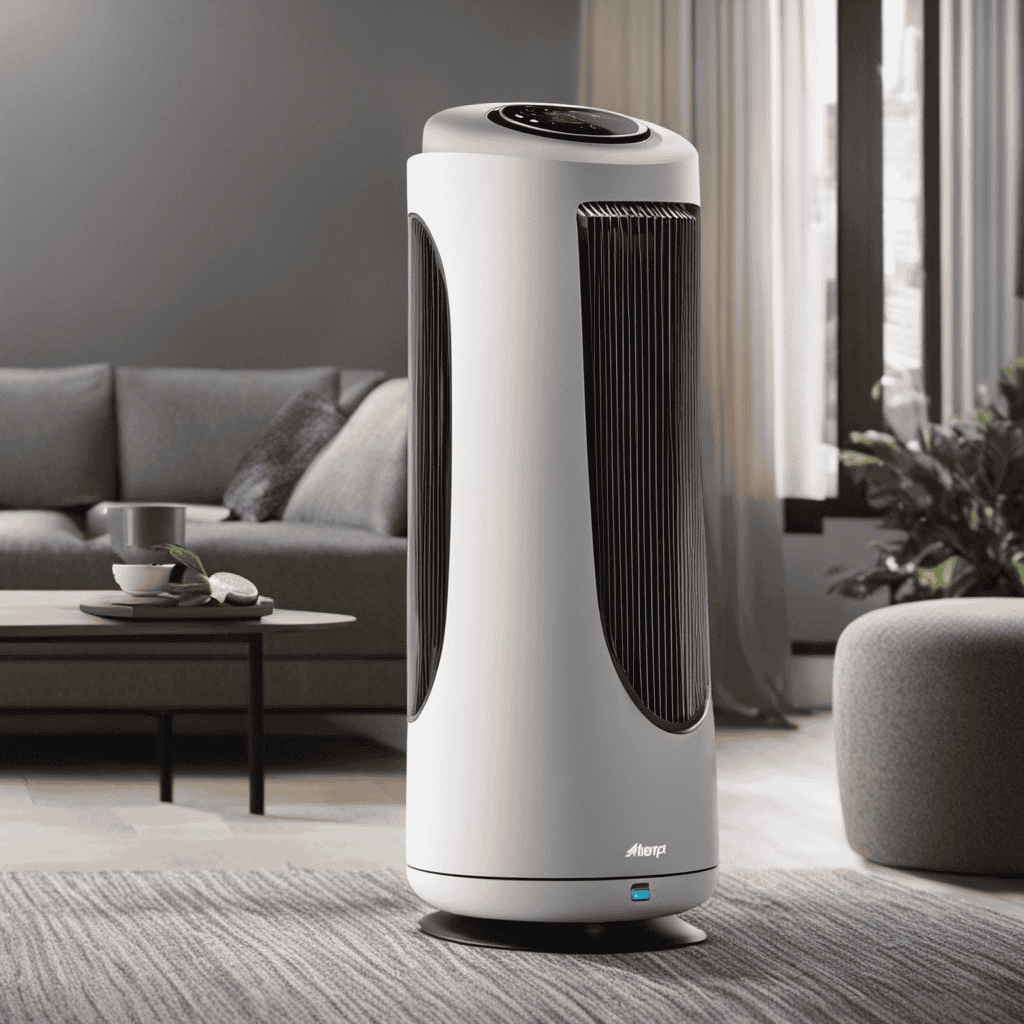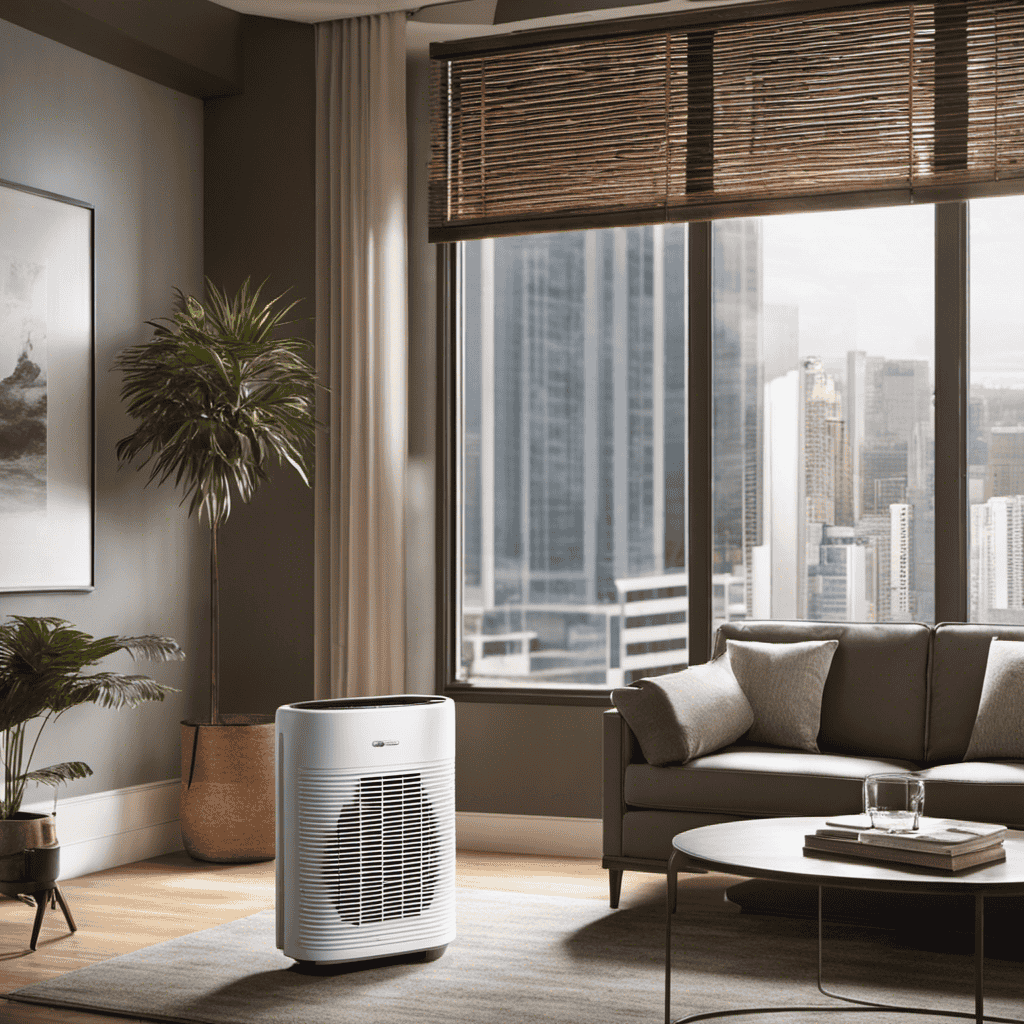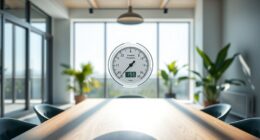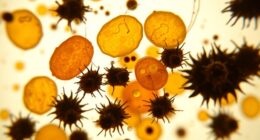Upon entering a room, I inhale deeply, aware that the air filling my lungs is pure and devoid of any dangerous pathogens.
How is this possible, you may ask? The answer lies in the power of UV light technology in air purifiers.
In this article, I will explore the advantages of UV light in air purification, from its ability to eliminate allergens and combat viruses to its impact on indoor air quality.
Get ready to discover the science behind a healthier living environment.
Key Takeaways
- UV light technology in air purifiers provides a chemical-free and non-toxic method of disinfection.
- UV light effectively kills bacteria, viruses, and mold spores, improving indoor air quality and reducing the risk of respiratory infections and allergies.
- UV light breaks down volatile organic compounds (VOCs) and eliminates unpleasant odors in the air.
- Regular cleaning and maintenance of UV light air purifiers, including replacing UV lamps when necessary, ensures optimal performance and longevity.
Uv Light Technology Explained
UV light technology, also known as ultraviolet germicidal irradiation (UVGI), is commonly used in air purifiers to kill bacteria and viruses. This technology utilizes the powerful properties of UV light to disinfect the air. UV light works by damaging the DNA of microorganisms, preventing them from replicating and causing diseases. When air passes through an air purifier equipped with UV light technology, the UV rays penetrate the cells of bacteria and viruses, rendering them harmless.
The benefits of UV light in air purification are numerous. It provides a chemical-free and non-toxic method of disinfection, eliminating the need for harsh chemicals or filters. Furthermore, UV light technology is effective against a wide range of pathogens, including bacteria, viruses, and mold spores. This makes it an excellent choice for improving indoor air quality and reducing the risk of airborne infections.
How Uv Light Kills Airborne Pathogens
When pathogens are exposed to UV light, they’re unable to replicate or cause harm. This is because UV light damages the DNA or RNA of these microorganisms, preventing them from reproducing or functioning properly.
When it comes to respiratory health, UV light can have a significant impact on allergies and asthma. Here’s how:
-
Inactivates allergens: UV light can effectively neutralize common allergens such as pollen, mold spores, and pet dander, reducing their presence in the air and minimizing allergic reactions.
-
Destroys bacteria and viruses: UV light has been shown to effectively kill bacteria and viruses that can cause respiratory infections, including the common cold and flu.
-
Reduces asthma triggers: By eliminating airborne pathogens and allergens, UV light can help reduce asthma triggers, leading to fewer asthma attacks and improved respiratory health.
-
Enhances indoor air quality: UV light in air purifiers can help maintain cleaner and healthier indoor air, benefiting individuals with respiratory conditions like allergies and asthma.
Overall, the use of UV light in air purifiers can play a crucial role in improving respiratory health by reducing the presence of pathogens and allergens in the air.
Benefits of Uv Light in Air Purification
Using UV light in air purification systems can greatly improve the quality of indoor air. This technology benefits air purification by effectively killing harmful pathogens such as bacteria, viruses, and mold spores. When exposed to UV light, these pathogens’ DNA and RNA become damaged, rendering them unable to replicate and causing them to die off. This not only helps reduce the risk of infections and allergies but also eliminates unpleasant odors caused by these microorganisms.
Additionally, UV light can break down volatile organic compounds (VOCs), which are common indoor air pollutants. By breaking down VOCs into harmless byproducts, UV light further enhances air purification.
Uv Light’s Impact on Indoor Air Quality
To improve the quality of the air you breathe indoors, consider incorporating UV light technology into your air purification system.
Indoor air pollution is a significant concern, with various harmful pollutants like bacteria, viruses, and mold spores circulating in the air. UV-C technology, also known as ultraviolet germicidal irradiation, can help mitigate these issues by effectively killing or deactivating these microorganisms.
Here are four reasons why UV light is beneficial for indoor air quality:
-
Eliminates bacteria and viruses: UV-C light has been proven to destroy the DNA and RNA of bacteria and viruses, rendering them unable to reproduce or cause harm.
-
Reduces mold and mildew growth: UV light inhibits the growth of mold and mildew by disrupting their cellular functions, preventing them from spreading and causing health problems.
-
Odor control: UV-C technology can also neutralize unpleasant odors in the air by breaking down volatile organic compounds (VOCs) that are responsible for the smells.
-
Improved respiratory health: By eliminating harmful microorganisms and reducing the presence of allergens in the air, UV light can help improve respiratory health and reduce the risk of respiratory illnesses.
Incorporating UV-C technology into your air purification system can significantly enhance the quality of the air you breathe indoors, providing a healthier and safer environment for you and your loved ones.
Uv Light as a Defense Against Allergens
As an expert in indoor air quality, I can confidently say that UV light is a powerful tool in eliminating allergens from the air.
UV light has been proven to effectively destroy allergens such as pollen, dust mites, and pet dander, reducing allergic reactions and providing relief for those suffering from allergies.
Additionally, UV light’s germ-killing properties make it an excellent defense against bacteria and viruses, including airborne pathogens that can cause respiratory illnesses.
Allergen Elimination Through UV
UV light in an air purifier can effectively eliminate allergens. This is especially beneficial for individuals with asthma and those who are sensitive to pet dander. Here are four key reasons why UV light is advantageous for allergen elimination:
-
UV light destroys the DNA of microorganisms: UV light has the ability to penetrate the cell walls of allergens, such as bacteria, viruses, and mold spores. This damages their DNA, rendering them unable to reproduce and effectively eliminating them from the air.
-
UV light neutralizes pet dander: Pet dander is a common allergen that can trigger asthma attacks and allergic reactions. UV light in an air purifier breaks down the proteins in pet dander, making them less allergenic and reducing the risk of respiratory symptoms.
-
UV light improves indoor air quality: By eliminating allergens, UV light helps improve the overall air quality in your home. This can lead to fewer allergy symptoms, reduced asthma triggers, and a healthier living environment.
-
UV light complements other air purification technologies: UV light can be used in combination with other air purification technologies, such as HEPA filters, to enhance the effectiveness of allergen removal. This multi-stage approach ensures comprehensive allergen elimination from the air you breathe.
Germ-Killing Properties of UV
The germ-killing properties of UV make it an effective tool for eliminating harmful microorganisms. UV light has been widely used in germ killing technology due to its effectiveness in destroying bacteria, viruses, and other pathogens. When exposed to UV light, these microorganisms absorb the UV energy, which damages their DNA and prevents them from reproducing.
Numerous studies have demonstrated the effectiveness of UV light in reducing the spread of infectious diseases. For example, a study conducted in a hospital setting found that UV light significantly reduced the number of bacteria and viruses on surfaces. Another study showed that UV light effectively killed airborne viruses, providing a promising solution for preventing the transmission of respiratory infections.
These findings highlight the importance of UV light in germ-killing technology and its potential to create safer and healthier environments.
Airborne Virus Prevention
Using UV light can effectively kill airborne viruses, making it a valuable tool in preventing the spread of respiratory infections. Here are some important considerations for air purifier maintenance and UV light safety guidelines:
-
Regular cleaning: It’s crucial to clean and maintain your air purifier regularly to ensure its optimal performance. This includes cleaning or replacing filters and clearing any debris from the unit.
-
UV light safety: While UV light can effectively eliminate viruses, it’s important to follow safety guidelines to protect yourself. Avoid direct exposure to UV light and ensure that the air purifier has proper shielding to prevent any harm.
-
Timer settings: Some air purifiers with UV light feature timer settings. It’s recommended to follow the manufacturer’s instructions and set the timer appropriately to ensure the best and safest use of the UV light.
-
Professional servicing: Consider scheduling regular professional servicing for your air purifier to ensure that it’s functioning correctly and efficiently. Professionals can inspect and clean the unit thoroughly, ensuring its longevity and effectiveness in preventing airborne viruses.
Uv Light’s Role in Eliminating Odors
When it comes to eliminating odors, UV light plays a crucial role in ensuring effectiveness.
Not only does it neutralize unpleasant smells, but it also eliminates the bacteria and viruses that cause them.
The health benefits of UV light in this context cannot be understated, as it helps create a cleaner and healthier environment by reducing harmful pathogens in the air.
Odor Elimination Effectiveness
You’ll notice a significant improvement in odor elimination effectiveness with UV light in an air purifier. Here’s why:
-
Ultraviolet light kills bacteria and viruses: UV light has the power to destroy the DNA of microorganisms, including those that cause unpleasant odors. By eliminating these odor-causing agents, UV light helps to remove unwanted smells from the air.
-
Reduction of volatile organic compounds (VOCs): UV light can break down volatile organic compounds, which are common sources of odors in indoor spaces. As the UV light interacts with these compounds, it alters their chemical structure, leading to a reduction in odor.
-
Control of mold and mildew: Mold and mildew growth can contribute to persistent odors. UV light can inhibit the growth of these fungi, preventing the release of musty smells into the air.
-
Enhanced air purification effectiveness: When combined with other air purification technologies like HEPA filters, UV light can further enhance the overall effectiveness of odor removal. It acts as an additional line of defense, targeting the microorganisms and compounds that may not be captured by traditional filtration methods alone.
Health Benefits of UV
In addition to its effectiveness in eliminating odors, UV light technology in air purifiers offers several health benefits. UV light has been proven to be effective in neutralizing pathogens such as bacteria, viruses, and mold spores. This can help reduce the risk of respiratory infections and allergies caused by these microorganisms.
UV light also has the ability to break down volatile organic compounds (VOCs) that are released by common household items such as cleaning products and furniture. Exposure to high levels of VOCs can lead to various health issues, including eye, nose, and throat irritation, as well as long-term respiratory problems. By neutralizing VOCs, UV light helps improve indoor air quality and create a healthier living environment.
Here is a visual representation of the health benefits of UV light technology in air purifiers:
| Health Benefits of UV Light Technology | |
|---|---|
| Eliminates pathogens | Reduces respiratory infections and allergies |
| Breaks down VOCs | Improves indoor air quality |
| Creates a healthier living environment |
Overall, incorporating UV light technology in air purifiers provides significant health benefits by eliminating pathogens and reducing exposure to harmful VOCs, ensuring clean and healthy indoor air.
Uv Light’s Effectiveness in Removing Mold and Mildew
Using UV light in my air purifier has been a game-changer when it comes to removing mold and mildew. The effectiveness of UV light technology in tackling these issues is backed by scientific evidence and has several advantages:
-
Elimination: UV light can effectively kill mold spores and prevent them from reproducing, ultimately eliminating the problem at its source.
-
Chemical-free: Unlike traditional mold removal methods that often involve harsh chemicals, UV light provides a natural and chemical-free solution.
-
Continuous protection: Once installed, UV light in the air purifier continuously works to prevent mold and mildew growth, keeping the air clean and healthy.
-
Energy-efficient: UV light technology is energy-efficient, consuming minimal power while providing maximum results.
Incorporating UV light technology in my air purifier has not only improved the air quality in my home but also provided me with peace of mind knowing that mold and mildew growth is effectively controlled.
Uv Light’s Ability to Combat Viruses and Bacteria
In addition to its effectiveness in removing mold and mildew, UV light in air purifiers also exhibits the ability to combat viruses and bacteria. When these microorganisms are exposed to UV light, it damages their DNA and prevents them from reproducing, effectively neutralizing their harmful effects.
This is particularly beneficial for respiratory health, as viruses and bacteria are often the cause of respiratory infections and allergies. By eliminating these pathogens from the air, UV light helps reduce the risk of respiratory illnesses and alleviate allergy symptoms.
Studies have shown that UV light can significantly reduce airborne allergens such as pollen, dust mites, and pet dander, providing relief for individuals with allergies. The impact of UV light on respiratory health and its ability to reduce allergies make it a valuable addition to air purifiers.
Transitioning into the subsequent section, let’s explore how UV light contributes to a healthier living environment.
Uv Light’s Contribution to a Healthier Living Environment
To create a healthier living environment, you can rely on the contribution of UV light in neutralizing harmful microorganisms. UV light technology has proven to be effective in reducing allergens and improving indoor air quality.
Here are four key points to consider when comparing different UV light technologies:
-
UV-C wavelength: The most effective UV light for neutralizing microorganisms is in the UV-C spectrum, specifically around 254 nanometers. This wavelength has the highest germicidal activity.
-
Intensity and exposure time: The effectiveness of UV light in killing microorganisms depends on the intensity and exposure time. Higher intensity and longer exposure times result in better disinfection.
-
Maintenance and lifespan: Different UV light technologies require varying levels of maintenance. It’s important to consider the lifespan of the UV lamps and the frequency of replacement or cleaning required.
-
Safety features: UV light can be harmful to humans if not used properly. Look for air purifiers with built-in safety features such as automatic shut-off when the device is opened or tilted.
How Does UV Light in an Air Purifier Provide an Advantage for Air Quality?
UV light in air purifiers provide a significant advantage for air quality by effectively eliminating bacteria, viruses, and mold spores. The UV light damages the DNA of these harmful microorganisms, preventing them from reproducing and causing potential health issues. This technology offers a powerful solution for maintaining a clean and healthy indoor environment.
Frequently Asked Questions
Can UV Light in an Air Purifier Damage My Skin or Eyes?
UV light in an air purifier can pose potential health risks if not used properly. It can damage the skin and eyes if exposed for prolonged periods. Follow safety guidelines to mitigate these risks.
How Long Do UV Light Bulbs Typically Last in an Air Purifier?
UV light bulbs typically last around 9,000-10,000 hours in an air purifier. The longevity of UV bulbs is important for the effectiveness of UV light in air purification, ensuring continuous germ-killing capabilities.
Do I Need to Replace the UV Light Bulbs in an Air Purifier Regularly?
I do need to replace the UV light bulbs in my air purifier regularly. Research shows that UV light effectiveness decreases over time, so frequent replacement ensures optimal air purification.
Does UV Light in an Air Purifier Eliminate All Types of Allergens?
UV light in an air purifier is effective in killing bacteria and viruses, which can help eliminate certain types of allergens. Additionally, it has potential health benefits by reducing the spread of airborne pathogens.
Can UV Light in an Air Purifier Completely Eliminate the Need for Other Cleaning Methods?
UV light in an air purifier can greatly reduce the need for other cleaning methods. Its effectiveness in eliminating airborne viruses and bacteria surpasses traditional purification methods, making it a valuable addition to any home.
Conclusion
In conclusion, the advantage of using UV light in an air purifier is truly remarkable. It is a powerful weapon against airborne pathogens, allergens, and odors, contributing to a healthier living environment.
UV light technology effectively eliminates mold, mildew, viruses, and bacteria, ensuring the air we breathe is clean and safe. Its impact on indoor air quality cannot be overstated.
So, if you want to create a euphemistically delightful atmosphere, investing in an air purifier with UV light technology is the way to go.
